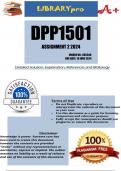Summary
Summary Economics of Healthcare (HPI4001)
- Module
- Institution
Summary of the course Economics of Healthcare (HPI4001) of the master Healthcare Policy, Innovation and Management. All lectures tutorials. For me, this summary leaded to a 7.6. Made in academic year . Used literature can be found on the first pages of the document: this will largely accord with...
[Show more]












